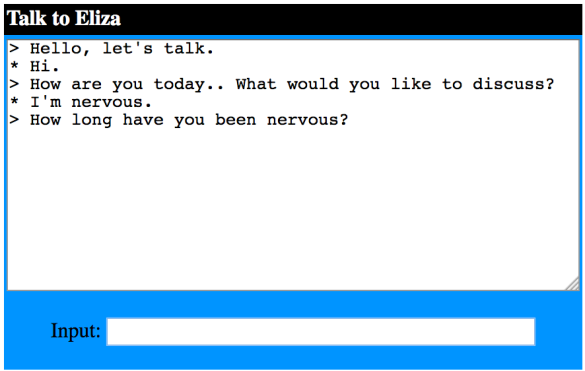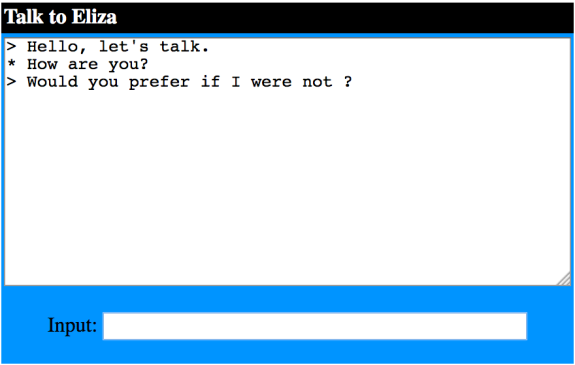Our old friend and 60’s darling, ELIZA, utters like a Rogerian psychotherapist. She asks about you, affirms things you have said, however finding out about her feelings is an elusive task.
ELIZA isn’t a human. She is one of the earliest chatbots created by computer scientist Joseph Weizenbaum at MIT. Weizenbaum considered ELIZA to demonstrate an example of communication between machine and human, particularly highlighting the lack of depth in this exchange. Surprisingly, even with her short and repetitive utterances, some people attributed to her a level of human understanding.
How did ELIZA work?
It wasn’t that she could read the user’s mind, rather, she affirms what the user says through a cascade of regular expression subsitutions used to tweak the user’s input. An example is seen below, where ELIZA has picked up on the user’s sentence structure and used substitution for her output as seen below.
The first change would be from the user’s first person utterances into second person, my to your and I am to you are.
Then, specific utterances have been written to include the user’s input information. Such as in the case below, it might have been written like this:
s/.*YOU ARE (nervous|depressed|upset).*/HOW LONG HAVE YOU BEEN\1/
If you talk to ELIZA, you can see she has a few of these utterances that are randomly chosen as her output. So she might ask you,
s/.*YOU ARE (nervous|depressed|upset).*/DO YOU THINK IT’S NORMAL TO FEEL\1/

What it takes to be human
ELIZA was crafted using a rule-based approach, meaning that her output is dependent on the language rules written by the designer, mostly based on what the user decides to contribute. In this case, ELIZA never really states her own personal opinion or gives her own view on the matter. The designer meticulously decides on what topics and/or voices she wishes to cover in which ELIZA’s feelings doesn’t make the coverage, as seen below.

The main challenge of the rule-based approach for natural language chat programs is that it is common for unexpected user utterances to occur. Human language is colourful and spontaneous that a sarcastic tone may throw off a meticulously written script.
Broadening the conversation
Decades onwards from ELIZA, the rule-based approach is still the most commonly integrated. Mitsuku, a chatbot created by Steve Worswick and which won the 2016 Loebner prize, illustrates a program that covers a more detailed scope of user input.
Designers and computer scientists are now looking at ways to move from a rule-based only approach towards retrieval-based systems and systems that capitalise on both rule-based and retrieval-based natural language processing modules. An interesting example of this is seen in research done by Higashinaka et. al. (2014), where their conversation system included retrieval aspects, specifically using Twitter to gather context from users and plausible utterances, alongside rule-based mechanisms which included a form of dialogue control where the user’s three previous dialogue acts were taken into account and contributed to generating the next utterance. They had found their system overall did not work as well as a meticulous rule-based program such as Mitsuku, as judged by number of unique words and utterances, however the quality of conversation was promising.
Exploring avenues where large amounts of users’ speech data can be retrieved, such as on social media, may contribute to a broader coverage of conversation for the modern chatbot. The real NLP challenge regarding this would be to figure out how to determine what is meaningful and what is noise. For humans, to communicate means to do a whole lot of things, it’s not just language rules, but we are finding creative ways to mimic human conversation. ELIZA in 2017 wouldn’t be as close to a human level and she might not ever be, yet it’s still fun to try and do the impossible.
References
Jurafsky, D. & Martin J.H. (2000) Speech and Language Processing.
Higashinaka et. al. (2014) Towards an open-domain conversational system fully based on natural language processing.
